A Beloved Author’s Journey
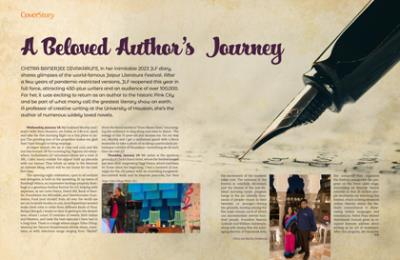
CHITRA BANERJEE DIVAKARUNI, in her inimitable 2023 JLF diary, shares glimpses of the world-famous Jaipur Literature Festival. After a few years of pandemic-restricted versions, JLF reopened this year in full force, attracting 450-plus writers and an audience of over 100,000. For her, it was exciting to return as an author to the historic Pink City and be part of what many call the greatest literary show on earth. A professor of creative writing at the University of Houston, she’s the author of numerous widely loved novels.
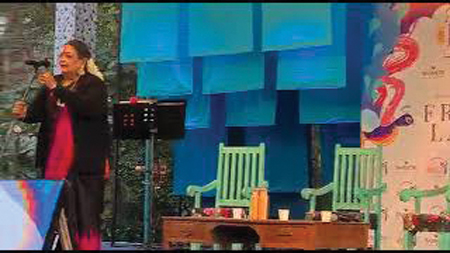
Wednesday, January 18: My husband Murthy and I reach Delhi from Houston, via Dubai, at 2:40 a.m. (yes!) and take the first morning flight on a tiny plane to Jaipur. The grinding roar of the propellers makes me glad that I had thought to bring earplugs.
[Right] Singer Usha Uthup (Photo: JLF)
At Jaipur airport, the air is crisp and cool, and the sun has burned off the morning fog. Pigeons coo everywhere. Enthusiastic JLF volunteers (there are a total of 300, I later learn) outside the airport hold up placards with our names. They whisk us away to the Marriott on Ashram Marg, which will be our home for the next five days.
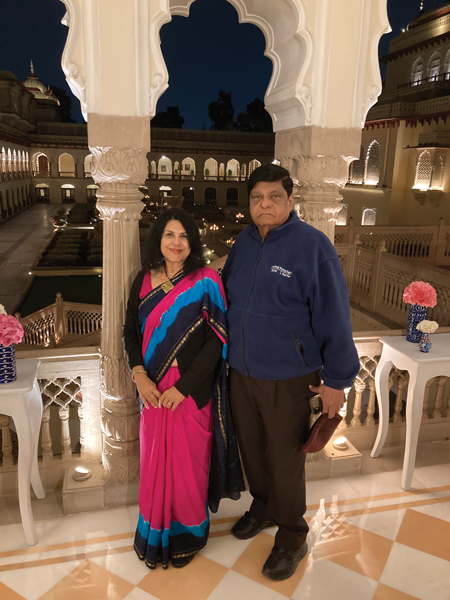
The opening-night celebration, open to all authors and delegates, is held on the sprawling, lit-up lawns of Rambagh Palace, an impressive heritage property. Rambagh is a generous Festival Partner for JLF, helping with expenses, as are Leela Palace, Dettol BSI, Bank of Baroda, Foundation Jan Michalski, and Hawthornden Foundation. Food (and drinks!) from all over the world are set out in lavish booths; in one, local Rajasthani women make fresh rotis to order from different kinds of flour. Being a Bengali, I waste no time in getting to the dessert area, where I count 25 varieties of sweets, both Indian and Western, and taste the best rasmalai I have had in a long time. There is a stage where singer Usha Uthup, wearing her famous Kanjeevaram tennis shoes, entertains us with infectious songs ranging from “Skyfall” (from the Bond movie) to “Dum Maaro Dum,” encouraging the audience to sing along and even to dance. The energy of this 75-year-old star amazes me. On our way out, Murthy and I get a uniformed guard with a fierce mustache to take a photo of us along a particularly picturesque corridor of the palace—something we do each time we visit JLF.
[Left] Chitra and Murthy Divakaruni
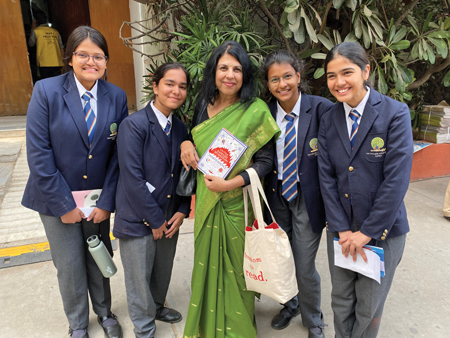
Young fans of Chitra (Photo: Murthy)
Thursday, January 19: We arrive at the spacious grounds of Clark’s Amer Hotel, where the festival moved last year after outgrowing Diggi Palace, which had been its home since the beginning. I feel a moment of nostalgia for the old palace with its crumbling bougainvillea-covered walls and its raucous peacocks, but then the excitement of the moment takes over. The entrance to the festival is colorfully decorated, and the strains of the just-finished morning music program hangs in the air. Literally thousands of people—many in their twenties or younger—throng the grounds, moving among the five main venues, each of which can accommodate several hundred people. Founders Namita Gokhale and William Dalrymple, along with Sanjoy Roy, the managing director of Teamwork Arts, the company that organizes the festival, inaugurate the program on the Front Lawn stage, welcoming us warmly. Sanjoy informs us that 25 million people worldwide are watching this festival, which is being streamed online. Namita states the festival’s commitment to showcasing Indian languages and translations. Nobel Prize winner Abdulrazak Gurnah gives an eloquent keynote address about writing as an act of resistance. After the program, we meander around the festival, stopping to listen to snippets of discussion about subjects as varied as the Brahma Purana, John Donne, and the extremely popular romantic novels of Durjoy Dutta. People recognize me and ask to take selfies; I feel like a rock star! We have a delicious lunch buffet at the Authors Lounge (courtesy of the Leela Palace, which will also sponsor a Writers Ball on the last night), while guards at the gate keep the paparazzi away. I lounge on cushions, sip fresh coconut water, and admire the tote bag my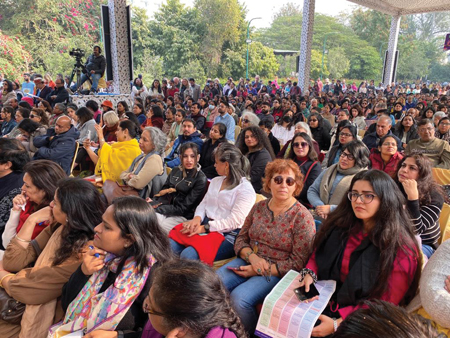 publisher has gifted me, embroidered with the cover of my new novel, Independence. It is an added pleasure to meet new authors and greet old acquaintances. I have my own fan moments as I tell Siddhartha Mukherjee (The Emperor of All Maladies), Shefan Karunatilaka (The Seven Moons of Maali Almeida), and Geetanjali Shree (Tomb of Sand) how much I’ve enjoyed their books.
publisher has gifted me, embroidered with the cover of my new novel, Independence. It is an added pleasure to meet new authors and greet old acquaintances. I have my own fan moments as I tell Siddhartha Mukherjee (The Emperor of All Maladies), Shefan Karunatilaka (The Seven Moons of Maali Almeida), and Geetanjali Shree (Tomb of Sand) how much I’ve enjoyed their books.
[Right] Chitra’s packed event (Photo: Murthy)
My main responsibility today is to be in conversation with Shobhaa De, as part of the inauguration of her autobiographical book, Insatiable. Shobhaa at 75 is elegant and witty, and we have a great time discussing the themes of friendship, food, family, and fashion that are woven through her book. After dinner at the Authors Lounge, there’s a music concert (there are concerts every night). Murthy and I enjoy Pakshee, a band that performs a blend of jazz and Carnatic vocals.
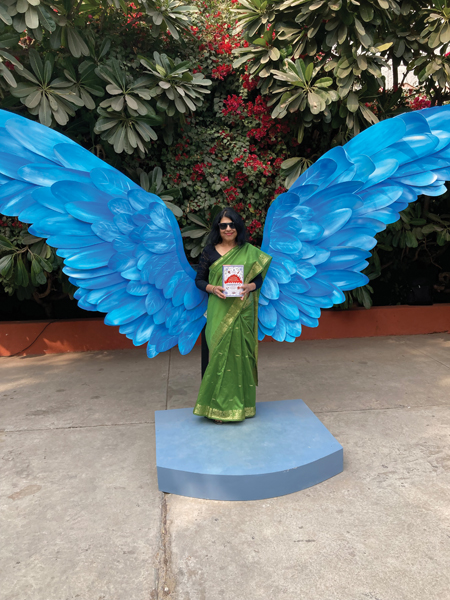
Friday, January 20: After being interviewed in the Media Building by 15 different journalists about Independence, I am free to wander around. Murthy and I listen to the extremely popular Sudha Murty speaking wittily about her books and beliefs. We attend Bibek Deb Roy’s discussion of Grasping Greatness: Making India a Leading Power, an anthology analyzing Indian policy over the years. JLF is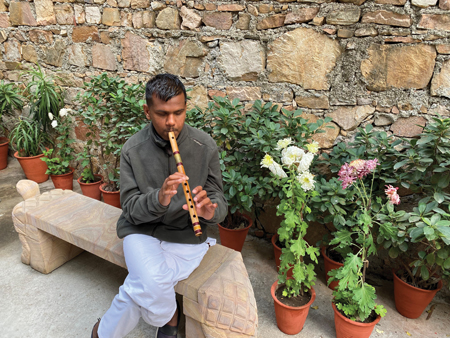 famous for arts installations, too. We enjoy the beautiful painting titled “The World Sits on My Toenail: Vishwaroopa” (commissioned by Ojas Arts, headed by Anubhav Nath), depicting the universal connection we share with our planet, and listen to the artists describing their process. A blind flute player’s haunting melodies wind their way around us as we head to the Author’s Lounge. In the lounge, I wave to Shashi Tharoor—we’ve known each other since 1998, when I published The Mistress of Spices and he wrote a generous review of it. I’m delighted to run into Daisy Rockwell, Geetanjali Shree’s wonderful translator. She is visiting the festival with her charming teenage daughter, Seraphina, and we talk about the delights—and perils—of traveling in India with children.
famous for arts installations, too. We enjoy the beautiful painting titled “The World Sits on My Toenail: Vishwaroopa” (commissioned by Ojas Arts, headed by Anubhav Nath), depicting the universal connection we share with our planet, and listen to the artists describing their process. A blind flute player’s haunting melodies wind their way around us as we head to the Author’s Lounge. In the lounge, I wave to Shashi Tharoor—we’ve known each other since 1998, when I published The Mistress of Spices and he wrote a generous review of it. I’m delighted to run into Daisy Rockwell, Geetanjali Shree’s wonderful translator. She is visiting the festival with her charming teenage daughter, Seraphina, and we talk about the delights—and perils—of traveling in India with children.
[Top] A flute player (Photo: Murthy)
Saturday, January 21: I listen to Shehan Karunatilaka’s excellent, hard-hitting talk on his Booker Prize novel, and catch a portion of Aanchal Malhotra’s discussion of her Partition books, which I have enjoyed, particularly Remnants of Partition. I look in on a Hindi panel starring Geetanjali Shree. It is great to see JLF’s championship of the Bhasha writers.
In the Mughal Tent, I inaugurate Madhushree Ghosh’s Khabaar: An Immigrant Journey of Food, Memory, and Family. It is Madhushree’s first book, a wonderful blend of biography, recipes, ghost stories, and musings on violence against women. Madhushree, who is also a scientist, speaks eloquently about her father, a refugee from East Pakistan. She wears delightful gold earrings in the shape of tiny tea-kettles that sparkle as she nods. Our allotted time ends too quickly; I urge the audience to continue their conversation with her—and check out the cool earrings—over book signing.
This is the night traditionally reserved at JLF for publisher parties. I’m invited to HarperCollins’ 30th anniversary celebration at the City Palace of Jaipur, whose green gateway graces the cover of my novel The Palace of Illusions. Ananth Padmanabhan, CEO of HarperCollins India, comes over to say a gracious hello,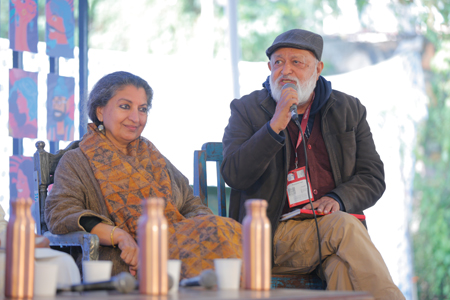 along with Charlie Redmayne, CEO of HarperCollins UK. Waiters carry trays upon trays of delicious hors d’oeuvres and drinks. The dessert tables are laden with tall multi-layered cakes. The entire pavilion sparkles with lamps, adding an aura of enchantment to the night. ‘Where but in Jaipur,’ Murthy and I whisper to each other.
along with Charlie Redmayne, CEO of HarperCollins UK. Waiters carry trays upon trays of delicious hors d’oeuvres and drinks. The dessert tables are laden with tall multi-layered cakes. The entire pavilion sparkles with lamps, adding an aura of enchantment to the night. ‘Where but in Jaipur,’ Murthy and I whisper to each other.
[Right] Authors Geetanjali Shree and Pushpesh Pant (Photo: JLF)
Sunday, January 22: My last day at Jaipur—tomorrow I will leave for the Kolkata Lit Meet festival. Today my new novel, Independence, will be inaugurated. I dress in a black sari with kantha embroidery (kantha is of great significance to my novel, as this art often allowed women to become financially independent) and hurry to the Front Lawn stage. I have a moment of panic. What if no one shows up? But thankfully, the seats are full; people are even standing in the back. Sudha Murty graciously inaugurates my book. Aanchal Malhotra conducts a conversation, asking incisive questions about how Partition affected Bengal, where the book is set, and about the three sisters who are my main characters. I speak about the importance of spotlighting women protagonists, particularly in novels depicting tumultuous historical times. The long line at book signing takes well over an hour. Many of my readers are young women. In addition to Independence, they carry battered copies of Palace of Illusions and tell me 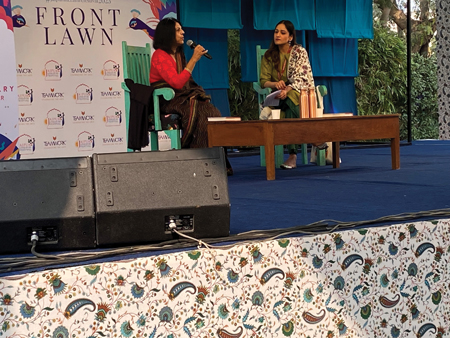 how the book made them see their lives in a different way. I am grateful and humbled. By the time I finish, it is time to run to my next responsibility: the inauguration of The Half Empress by Tripti Pandey, a novel about the life of the courtesan Raskapoor. I commend Pandey for bringing suppressed female narratives to light.
how the book made them see their lives in a different way. I am grateful and humbled. By the time I finish, it is time to run to my next responsibility: the inauguration of The Half Empress by Tripti Pandey, a novel about the life of the courtesan Raskapoor. I commend Pandey for bringing suppressed female narratives to light.
[Left] Chitra with writer Aanchal Malhotra (Photo: Murthy)
Tonight is the biggest celebration of all: the Heritage Evening at Amer Fort (which some may remember from the film Jodha Akbar). Built on a hill, the fort is an impressive example of Rajput architecture from 1592 with its many gates, large ramparts, and winding roads that lead to the main entrance. Its cobbled paths are murder on high heels but, scarred by prior experience, I have wisely worn my running shoes. The entire fort, beautifully lit up, looks magical. The glittering walls of the sheesh mahal pull me into the past. A dance performance, “Ahuti,” the highlight of the evening, is a collaboration between Nrityagram Dance Ensemble, a premier Indian Classical dance institute based in a dance village in Karnataka, and the Chitrasena Dance Company, a folk/traditional group from Sri Lanka. I am mesmerized by the lithe yet startling movements of the dancers, the power with which they bring to life the story of Shiva burning Kamadeva, the Lord of Desire, to ashes. Suddenly I catch a movement along the dark line of the roof. Several monkeys are cautiously observing us, intruders in their domain. The evening ends with a sumptuous Rajasthani dinner—but there is also, in the spirit of collaboration that marks the evening, chocolate cake! As our car wends its way along the hairpin turns, I crane my head so I can look at Amer for as long as is possible.
Goodbye, Jaipur. Goodbye JLF. I leave a portion of my heart with you each time I come here. I take back with me so many life-learnings, so many good books, and a renewed desire to become a better writer.
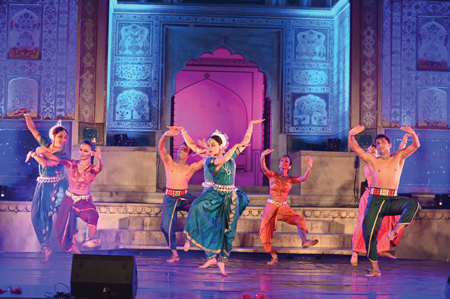
A dance performance (Photo: JLF)
“Independence is a very visual novel”
In a lively interview with Khabar, Chitra Banerjee Divakaruni talks about her new novel, what inspires her, how she writes, the freedom struggle and freedom songs, her journey as an author—and she also notes, before offering advice to writers, how poetry and painting influence her fiction.
By Dr. RAJESH C. OZA
Chitra, congratulations on bringing to vivid life the sisters Deepa, Jamini, and Priya! Could you have imagined all the characters you have created since your “Yuba City Wedding” was published in Living In America (Note: Chitra and I had contributed to this 1995 anthology featuring South Asian American writers)?
Thank you for the kind words. I had never imagined any of this. My writing life has been an astonishment to me, a gift from the universe. For one thing, at that time I was only writing poetry. I did not think I would become a fiction writer. Nor did I dream that my novels would reach so many people and be taught in colleges and universities and even become bestsellers.
And could you have imagined the proliferation of South Asian writers being published in the West?
No. At that time there were only a small handful of us writing. It is a joy to see how many South Asians and South Asian Americans are being read, reviewed, and loved. It is a very healthy trend, contributing to improved cross-cultural understanding, which we badly need.
Onward to your marvelous new novel, Independence. What came first? Setting? Character? Plot? Theme?
For Independence, the theme and characters came almost simultaneously. Setting was part of it, since I knew the novel was going to be about India’s freedom struggle in the 1940s, and in my mind the three sisters were from Bengal. (This to me was important—not much has been written about the independence movement in Bengal, which is where I am from.) Plot for me always comes last. I figure and re-figure plot and change events even as I’m writing.
Given that The Mistress of Spices (directed by Paul Berges) was adapted into a film starring Aishwarya Rai, did any part of you write Independence with Hollywood, Bollywood, or Tollywood in mind? It certainly has a cinematic feel to it.
I’m a very visual writer (I used to be a painter before I focused exclusively on writing), so Independence is a very visual novel. I have to imagine scenes happening. It’s a dramatic story because those were dramatic times, with people rising to their best potential—or falling to their worst. I agree, it would make a great movie. It has been optioned, so please keep your fingers crossed.
Double congratulations on having your novel optioned! Do you storyboard your scenes the way Satyajit Ray used to? If not, how do you approach scene creation and subsequent revision. I find it fascinating that both you and Ray were initially painters. Which other renowned writers began their careers as painters? Besides Ray and Tagore, off the cuff, I can think only of Tolstoy, Gogol, Kipling, and Hesse.
No, I don’t storyboard. I do it in my head. I sit in our scruffy old recliner and close my eyes and things become clear to me somehow. I can’t quite explain it. And the names you mentioned of painter-writers: those are the only ones I know. But many, like Auden, had a real affinity for art and wrote poems about pieces that moved them.
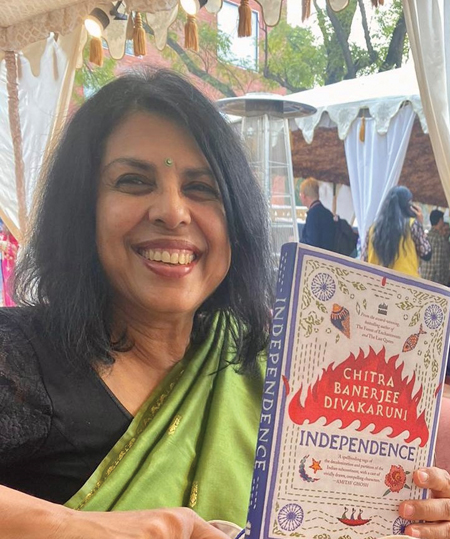
Can you say a little bit about the role music plays in this novel? The songs of Tagore and Nazrul are quite prominent.
The freedom songs (Tagore’s, Nazrul’s, Bankim Chandra’s “Vande Mataram,” etc.) were extremely important in India’s freedom movement and motivated people even as they marched, were beaten up, jailed, shot to death, etc. Sadly, we have largely forgotten about this, so I wanted to make the songs a big part of the novel. Two of the sisters and their father are talented singers, and music becomes a motivation for them as well to rise to their better selves.
Throughout the margins of my copy of Independence you will find a “D” with a circle around it. This is meant to highlight descriptive writing that feels particularly original and poetic. How does your life as a poet inform your fiction?
From the time I started writing poetry, images have been central to my writing. As I said, I am a visual person. And I feel images (especially of nature) dynamically express things that would be lost if I tried to describe or explain them. So images are extremely important in Independence.
Most parents say that they don’t have a favorite child. Are you the same with your characters? Do you have a favorite in Independence who is particularly close to your heart? Or do you love them all equally? Perhaps you love each one but in different ways? Anything about Priya’s immigrant experience that resonates with your own?
I love each of the sisters in a different way. None of my characters are perfect (and that is important, because none of us as humans are perfect). But each one, in this novel, will grow and learn the meaning of independence, sometimes through pain, and I loved that about all of them. Priya’s immigrant experience in the U.S. certainly resonates with mine, since she and I both came here to study. But in the 1940s, when she arrived in New York, things were very different, so I had to do a lot of research!
I appreciate how you give even minor characters a name (e.g., “Ganesh the gatekeeper, who carries an ancient rifle no one has used in years.”). Is there a worldview behind making each character a star of their own show? Also, I love how you use the “ancient rifle” to give some roundness to what would otherwise be flat characterization.
Yes, you are right once again. Each character, I believe, even if they appear briefly, must come alive and be memorable. I hope that has happened in the novel. Each person is important in their own sphere. Each serves a function, even the nameless ones I depict in the crowds. Particularly in this novel, they play a role—positive or negative—in India’s independence.
Before we close, I’m sure you know that there are many writers and aspiring writers who read Khabar. I have a rapid series of craft questions that I picked up from Daniel Alarcon’s The Secret Miracle. First, what triggers your stories?
Powerful, sometimes random, images that float up in my mind.
When writing historical fiction, do you do any research before you begin writing? Or does the research come later so that it does not constrain your imagination?
I research a lot before and a lot more as I’m writing.
How long does it take to get a good first draft of a novel done?
One year usually, not counting research time.
How polished do you try to make a first draft?
It’s just the basic story at this point.
How many revisions before you put the novel to rest?
At least two, maybe three. Independence needed four.
If I remember correctly, in your early days you had a writers group in California. Do you still have loyal readers who give you feedback before you publish your work? Or is it now all between you and your editor?
I belong to a writers group and we meet online. Then it goes to my editor.
What is one piece of advice that you wish someone had given you before you began writing fiction?
Join a writing program. That way you’ll get people who are writers and teachers to critique your work.
Is writing just another job or is it a miracle?
Always a miracle for which I am grateful.
Shall we end in the tradition of The New York Times Book Review? You’re organizing a literary dinner party. Which three writers, dead or alive, do you invite? The twist here is that they must have written a novel that depicts India’s freedom struggle.
A dinner with Tagore (Home and the World), Amrita Pritam (Pinjar), and E.M. Forster (A Passage to India) would make for a spirited conversation!
Your novel now sits on my shelf next to the other classic fictional retellings of India’s independence.
Thank you!
Independence to Interdependence
INDEPENDENCE – by Chitra Banerjee Divakaruni. William Morrow, 2023.
Reviewed by Dr. RAJESH C. OZA
The title of Chitra Banerjee Divakaruni’s latest novel could easily have been Interdependence. Set during the years 1946-1947 (with a 1954 epilogue), the surface story is about three sisters—Deepa, Jamini, and Priya Ganguly—negotiating their independence, with India’s own freedom from British imperialism in the background. To be sure, 1947 also marked the birth of Pakistan, but since the novel is mostly set in Ranipur, a fictional village nestled between metropolitan Calcutta and Dacca, the ethos is Bengali across all five parts of the novel.
Each part opens with a brief, delicate re-telling of the subcontinent’s metamorphosis during years sandwiching independence. Part One: “The country is India, the year is 1946, the month is August. Everything is about to change.” Part Five: “Godse’s bullet finds Gandhi’s chest. Darkness descends, an age ends. The year is 1948. The month is January. Everything has changed.”
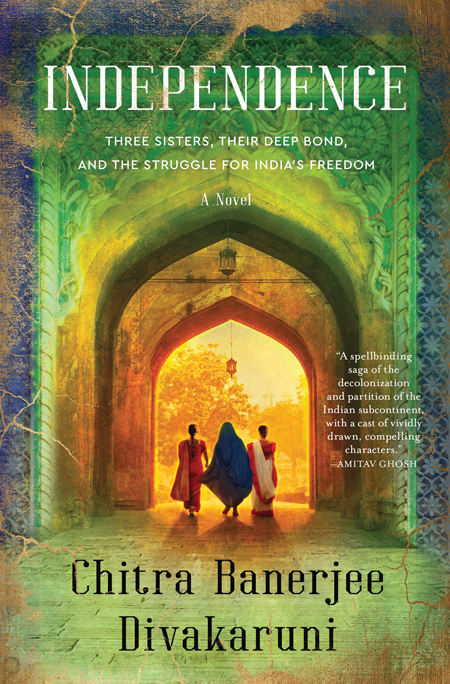
In the in-between-time, the changing lives of the Ganguly sisters echo that of their fissiparous land. By using a structure of chapters that alternate the point of view and interiority from one sister to the next, Independence champions pluralism. Like all great literature, this novel encouraged me to empathize with perspectives that are different from my own (e.g., I privilege passionate purpose over confident beauty).
“Deepa scintillates in her confident beauty, Jamini is pale with virtue and suppressed longing, Priya glows, passionate with purpose.” Perhaps because the narrator skillfully uses the lens of Manorama (who will be a mother-in-law to one of the sisters) to tell us that “Priya was more admirable,” I found myself rooting for her to marry Amit, Manorama’s gallant, if temperamental, son. Another reader might cheer on a different sister.
I was also sympathetic to Priya’s ambition to follow in the footsteps of her heroic physician father who dies in the midst of Hindu-Muslim violence. Priya eventually leaves for America to study medicine (a tender section of the novel which includes a fine reference to Anandibai Joshi, the first Indian woman to complete her medical studies in the United States; Sarojini Naidu is another historical figure who plays a cameo toward the end of the novel).
During Priya’s time abroad, Deepa, who has married across religious lines, finds herself isolated in East Bengal after her husband is killed; she is blessed with their daughter, Sameera, but cursed by the evil eye of a suitor who likely had a hand in her husband’s death. As for Jamini, she limps along through the novel,
neither beautiful like her elder sister, Deepa, nor brilliant like her younger sister, Priya; she longs for Amit who eventually does marry one of the sisters, but tragedy is always right around the corner. The novel deftly uses loss of loved ones to accelerate the agency of those left behind, women who embody “Durga, a no-nonsense goddess who does not wait for a man to solve her problems.”
Like India’s communal dynamics, the sisters’ relationships are complicated. They compete with each other, and they love each other. Who will receive most of their mother’s parsimonious affection? Who will side with their father in an argument? Who will marry a prince of a husband? Will they walk alone to the tune of Tagore’s “Ekla Chalo Re?” Or will they walk hand-in-hand-in-hand? As the title of this review hints, the sisters internalize an “immense precise truth [to] take care of each other.”
On the sisters’ road to find out, readers are gifted with lyrical descriptions that recall Satyajit Ray’s masterful direction of Teen Kanya (echoing Independence’s three daughters) and, of course, his Apu Trilogy: pastoral countryside, transitional train station, big-city hustle and bustle.
Given that novelist Divakaruni is also a poet, one is not surprised that her vivid and descriptive prose reads like poetry. In my experience, Bengalis on either side of the Indian/Bangladeshi border are Bengalis first, joined by a culture that long pre-dates Partition. Like the Ganga that flows from west to east to the Bay of Bengal, so many aspects of culture interconnect Bangla’s quilted golden land: food, clothing, religion, language, music, poetry.
Along with the sisterhood that primarily informs Independence’s narrative, a fraternity of Bangla poets—Rabindranath Tagore and Kazi Nazrul Islam, mainly—infuse this memorable novel with soulfulness, movement, and tenderness.
RCO is presently in Stanford University’s two-year novel-writing intensive. He hopes that his granddaughters will someday discover—in part through his writing—a sense of Indian interdependence in their American independence.
Enjoyed reading Khabar magazine? Subscribe to Khabar and get a full digital copy of this Indian-American community magazine.
blog comments powered by Disqus










